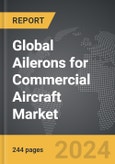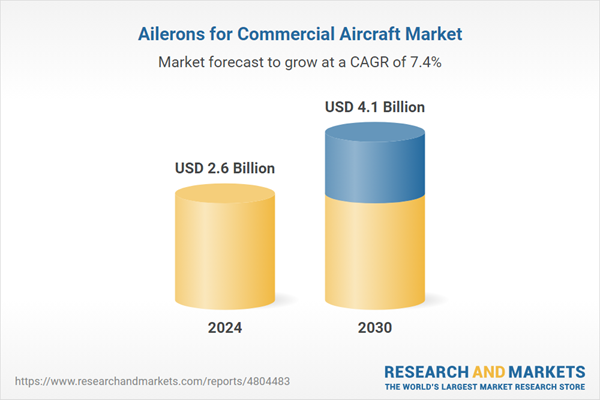Global Ailerons for Commercial Aircraft Market - Key Trends and Drivers Summarized
What Are Ailerons and Why Are They Crucial for Aircraft Maneuverability?
Ailerons are essential components located on the trailing edges of the wings of commercial aircraft, playing a crucial role in controlling the aircraft's roll and maintaining stability during flight. These hinged flight control surfaces work in opposition; when one aileron moves up, the other moves down, creating differential lift that causes the aircraft to roll to one side. This rolling action is fundamental for executing turns and maintaining balance, especially during takeoff, landing, and in-flight maneuvers. Modern aileron systems are designed to provide precise control and responsiveness, contributing to the overall safety and efficiency of the aircraft. Given their importance, advancements in aileron design and materials are continuously pursued to enhance performance, reduce weight, and improve fuel efficiency.How Are Technological Innovations Shaping the Future of Ailerons?
Technological advancements are significantly transforming the design and functionality of ailerons for commercial aircraft. One of the most notable developments is the adoption of composite materials, such as carbon fiber-reinforced polymers, which offer superior strength-to-weight ratios compared to traditional aluminum. These lightweight materials not only reduce the overall weight of the aircraft, leading to improved fuel efficiency and lower operating costs, but also provide enhanced durability and resistance to environmental stresses. Additionally, the integration of fly-by-wire systems, which replace traditional mechanical linkages with electronic controls, has revolutionized aileron operation. Fly-by-wire technology allows for more precise and responsive control inputs, improving the handling characteristics of the aircraft and enhancing passenger comfort. Innovations in additive manufacturing, or 3D printing, are also enabling more complex and optimized aileron designs, reducing production times and costs while allowing for greater customization and performance enhancements.Why Is There a Growing Demand for Advanced Ailerons in the Aviation Industry?
The aviation industry is experiencing a growing demand for advanced ailerons driven by the need for more efficient, reliable, and environmentally friendly aircraft. As global air travel continues to expand, airlines are seeking ways to improve fuel efficiency and reduce carbon emissions. Lightweight ailerons made from advanced composite materials contribute to these goals by lowering the aircraft's weight and enhancing aerodynamic performance. Furthermore, the increasing emphasis on aircraft safety and maintenance is driving the adoption of smart aileron systems equipped with sensors and diagnostic tools. These advanced systems enable real-time monitoring and predictive maintenance, reducing the risk of in-flight failures and extending the service life of the components. The trend towards electric and hybrid-electric aircraft also propels the demand for innovative aileron designs that can accommodate new propulsion systems and flight control technologies, ensuring compatibility and optimal performance in next-generation aircraft.What Factors Are Driving Growth in the Ailerons for Commercial Aircraft Market?
The growth in the ailerons for commercial aircraft market is driven by several factors reflecting technological advancements, regulatory pressures, and evolving industry needs. A significant driver is the increasing number of commercial aircraft deliveries, as airlines expand their fleets to meet rising passenger demand. This growth necessitates the production of high-performance ailerons that can improve aircraft efficiency and reduce operational costs. Technological innovations, such as the development of composite materials and fly-by-wire systems, are expanding the capabilities and applications of ailerons, making them more attractive to aircraft manufacturers. Government regulations aimed at enhancing aviation safety and reducing environmental impact are also propelling market growth, as compliance with these standards often requires the adoption of advanced aileron technologies. Additionally, the growing focus on sustainability and the development of eco-friendly aircraft are driving investments in research and development for lightweight, durable, and efficient aileron systems. Collaboration between aircraft manufacturers and aileron suppliers is fostering innovation and ensuring that new designs meet the stringent demands of modern aviation. As these factors converge, the market for ailerons for commercial aircraft is poised for robust expansion, driven by continuous advancements and the industry's commitment to improving safety, efficiency, and sustainability.Report Scope
The report analyzes the Ailerons for Commercial Aircraft market, presented in terms of units. The analysis covers the key segments and geographic regions outlined below.Segments: Aircraft Type (Wide-Body Aircraft, Narrow-Body Aircraft, Regional Jets).
Geographic Regions/Countries: World; United States; Canada; Japan; China; Europe (France; Germany; Italy; United Kingdom; and Rest of Europe); Asia-Pacific; Rest of World.
Key Insights:
- Market Growth: Understand the significant growth trajectory of the Wide-Body Aircraft Ailerons segment, which is expected to reach US$2.3 Billion by 2030 with a CAGR of a 7.9%. The Narrow-Body Aircraft Ailerons segment is also set to grow at 7.2% CAGR over the analysis period.
- Regional Analysis: Gain insights into the U.S. market, valued at $714.9 Million in 2024, and China, forecasted to grow at an impressive 7.0% CAGR to reach $632.5 Million by 2030. Discover growth trends in other key regions, including Japan, Canada, Germany, and the Asia-Pacific.
Why You Should Buy This Report:
- Detailed Market Analysis: Access a thorough analysis of the Global Ailerons for Commercial Aircraft Market, covering all major geographic regions and market segments.
- Competitive Insights: Get an overview of the competitive landscape, including the market presence of major players across different geographies.
- Future Trends and Drivers: Understand the key trends and drivers shaping the future of the Global Ailerons for Commercial Aircraft Market.
- Actionable Insights: Benefit from actionable insights that can help you identify new revenue opportunities and make strategic business decisions.
Key Questions Answered:
- How is the Global Ailerons for Commercial Aircraft Market expected to evolve by 2030?
- What are the main drivers and restraints affecting the market?
- Which market segments will grow the most over the forecast period?
- How will market shares for different regions and segments change by 2030?
- Who are the leading players in the market, and what are their prospects?
Report Features:
- Comprehensive Market Data: Independent analysis of annual sales and market forecasts in US$ Million from 2024 to 2030.
- In-Depth Regional Analysis: Detailed insights into key markets, including the U.S., China, Japan, Canada, Europe, Asia-Pacific, Latin America, Middle East, and Africa.
- Company Profiles: Coverage of players such as LAM Aviation, Inc., SAAB AB, Sealand Aviation Ltd., ShinMaywa Industries Ltd., Strata Manufacturing and more.
- Complimentary Updates: Receive free report updates for one year to keep you informed of the latest market developments.
Some of the 42 companies featured in this Ailerons for Commercial Aircraft market report include:
- LAM Aviation, Inc.
- SAAB AB
- Sealand Aviation Ltd.
- ShinMaywa Industries Ltd.
- Strata Manufacturing
- Turkish Aerospace Industries, Inc. (TAI)
- Zenith Aircraft Company
Tariff Impact Analysis: Key Insights for 2025
Global tariff negotiations across 180+ countries are reshaping supply chains, costs, and competitiveness. This report reflects the latest developments as of April 2025 and incorporates forward-looking insights into the market outlook.The analysts continuously track trade developments worldwide, drawing insights from leading global economists and over 200 industry and policy institutions, including think tanks, trade organizations, and national economic advisory bodies. This intelligence is integrated into forecasting models to provide timely, data-driven analysis of emerging risks and opportunities.
What’s Included in This Edition:
- Tariff-adjusted market forecasts by region and segment
- Analysis of cost and supply chain implications by sourcing and trade exposure
- Strategic insights into geographic shifts
Buyers receive a free July 2025 update with:
- Finalized tariff impacts and new trade agreement effects
- Updated projections reflecting global sourcing and cost shifts
- Expanded country-specific coverage across the industry
Table of Contents
Companies Mentioned (Partial List)
A selection of companies mentioned in this report includes, but is not limited to:
- LAM Aviation, Inc.
- SAAB AB
- Sealand Aviation Ltd.
- ShinMaywa Industries Ltd.
- Strata Manufacturing
- Turkish Aerospace Industries, Inc. (TAI)
- Zenith Aircraft Company
Table Information
| Report Attribute | Details |
|---|---|
| No. of Pages | 129 |
| Published | April 2025 |
| Forecast Period | 2024 - 2030 |
| Estimated Market Value ( USD | $ 2.6 Billion |
| Forecasted Market Value ( USD | $ 4.1 Billion |
| Compound Annual Growth Rate | 7.4% |
| Regions Covered | Global |









